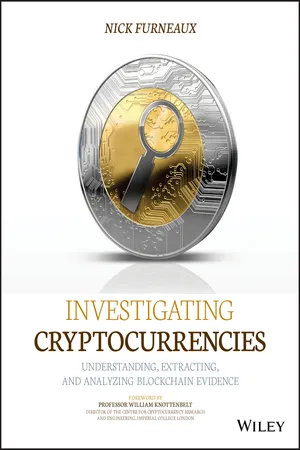
Investigating Cryptocurrencies
Understanding, Extracting, and Analyzing Blockchain Evidence
- English
- ePUB (mobile friendly)
- Available on iOS & Android
Investigating Cryptocurrencies
Understanding, Extracting, and Analyzing Blockchain Evidence
About this book
Investigate crimes involving cryptocurrencies and other blockchain technologies
Bitcoin has traditionally been the payment system of choice for a criminal trading on the Dark Web, and now many other blockchain cryptocurrencies are entering the mainstream as traders are accepting them from low-end investors putting their money into the market. Worse still, the blockchain can even be used to hide information and covert messaging, unknown to most investigators.
Investigating Cryptocurrencies is the first book to help corporate, law enforcement, and other investigators understand the technical concepts and the techniques for investigating crimes utilizing the blockchain and related digital currencies such as Bitcoin and Ethereum.
- Understand blockchain and transaction technologies
- Set up and run cryptocurrency accounts
- Build information about specific addresses
- Access raw data on blockchain ledgers
- Identify users of cryptocurrencies
- Extracting cryptocurrency data from live and imaged computers
- Following the money
With nearly $150 billion in cryptocurrency circulating and $3 billion changing hands daily, crimes committed with or paid for with digital cash are a serious business. Luckily, Investigating Cryptocurrencies Forensics shows you how to detect it and, more importantly, stop it in its tracks.
Frequently asked questions
- Essential is ideal for learners and professionals who enjoy exploring a wide range of subjects. Access the Essential Library with 800,000+ trusted titles and best-sellers across business, personal growth, and the humanities. Includes unlimited reading time and Standard Read Aloud voice.
- Complete: Perfect for advanced learners and researchers needing full, unrestricted access. Unlock 1.4M+ books across hundreds of subjects, including academic and specialized titles. The Complete Plan also includes advanced features like Premium Read Aloud and Research Assistant.
Please note we cannot support devices running on iOS 13 and Android 7 or earlier. Learn more about using the app.
Information
Part I
Understanding the Technology
CHAPTER 1
What Is a Cryptocurrency?
A New Concept?

Table of contents
- Cover
- Table of Contents
- Foreword
- Introduction
- Part I: Understanding the Technology
- Part II: Carrying Out Investigations
- Index
- End User License Agreement